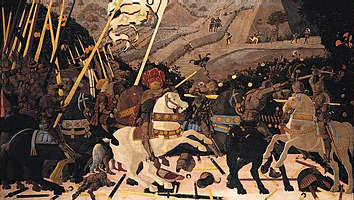
ENGLISH 240: Medieval Literature

The Battle of San Romano
Paolo Uccello (1397-1475)
probably about 1450-60 (British National Gallery)
Spring 2004 (Revision
in progress--dates may change!)
Instructor: Arnie Sanders
Department of English,
Goucher College
Post-Sabbatical Presentation, October 15, 2002
8/14/02 The Computing Proficiency in the English Major Exercises now are available online. All English Majors who have not yet completed the Computing Proficiency in the Major Exercises should plan to do so this semester, either in early September before assignments mount up, during midsemester break, or in the December-January break. Do not delay--it will hurt your scholarship and limit your writing to an audience of amateurs. If you intend to take English240, be aware that I will require completion of this requirement by the end of the add/drop period of Fall 2004 before I will allow you to take the course. It is essential to the midterm and final papers. In the past, students had not completed the requirement before taking the seminar had significant problems completing the course and their grades suffered as a result. Don't be shy. Come play with the pros!
If you are interested in how early literature was packaged for readers in manuscript and print editions, click here for an illustrated comparison of the manuscript and print editions of Sir Thomas Malory's Arthurian compilation usually known as Le Morte Darthur (1469-70/1485).
NB: Because we will be reading extensively in Middle English, you should begin immediately to teach yourself how to read it. The first difficulty to overcome is that the sound of English long vowels (ā, ē, ī, ō, and ū) changed in something linguists call the "Great Vowel Shift." If you know French or any other Romance language, you'll be at an advantage because Middle English long vowels sounded like they do now in Modern French (and you should know the reason why! [1066]). Consonant sounds also changed. As Middle English blurred into Early Modern English, they stopped pronouncing the "silent" consonants that make English spelling so delightful (e.g., knight, known, variable, sight). This caused the language to lose many of its Germanic sounds inherited from Anglo-Saxon or "Old English." Both changes may have had a lot to do with human laziness, though other socio-political factors may have been involved. Middle English is a much more "athletic" language to pronounce. To get started, click here to go to Larry D. Benson's online site which contains sound files you can use to teach your ear to hear and your mouth to produce Middle English sounds.
The other factor making Middle English difficult for Modern English speakers is that many of its words have fallen out of use, and others have changed their meanings over time. The Oxford English Dictionary (available at the Library via "All Electronic Databases") will show you words' oldest meanings first, and that will help you begin to understand how the language's meaning changed. For a good example, try "harlot," which in Chaucer's day meant something that allowed him to say, of a Canterbury pilgrim, "he was a gentle harlot" and mean a compliment. Pay attention to the glossed words and develop your own "hard word list." It's what every literate Elizabethan had to do when reading Chaucer, so you and Shakespeare are having the same trouble.
If you are interested in how early literature was packaged for readers in manuscript and print editions, click here for an illustrated comparison of the manuscript and print editions of Sir Thomas Malory's Arthurian compilation usually known as Le Morte Darthur (1469-70/1485). Kalamazoo 2002 version.
If you are interested in medieval manuscripts but feel intimidated by the jargon, click here for a link to Timothy Seid's online undergraduate introduction to manuscript interpretation. This site is strongly recommended for English majors considering graduate study in any era. Principles guiding manuscript interpretation are largely the same whether the manuscript is being sold by a medieval scribe or is being used by a modern author to compose a novel, poem or dramatic script. Manuscripts contain invaluable clues to authors' developing intentions for their works, and they are the ground for all scholarly editions of literary works.
Summary
English 240 is an intermediate level introduction to Medieval culture and Middle English literature. We will focus on the "courtly makers" of English poetry, following the general topics of love and death. In addition, we will read contemporary non-fiction materials to help students reconstruct the medieval socio-political and theological world in which that loving and dying took place.. Our objectives are to understand how Medieval people actually encountered their literature and culture through period documents and historical studies, and to understand the rules followed by Medieval artists, especially their debt to and modifications of the classical traditions of Greece and Rome. We approach Middle English literature through five major genres: lyric, dream vision, romance, Breton lai, and the didactic essay.
The historical materials will provide a basis for knowing how Medieval literature drew upon and embellished the lived experience of the Middle Ages. Students are cautioned, however, to beware the tendency to read literature as a literal picture of medieval life. Even avowedly mimetic artists transform their subjects according to genre rules, and their audiences have to follow similar rules in order to perceive the mimesis or re-presentation of reality. To know the literature, we have to know both how poets' audiences actually experienced events as well as poets' rules for describing those events and the rules they expected their audiences to follow when interpreting their texts.
|
|